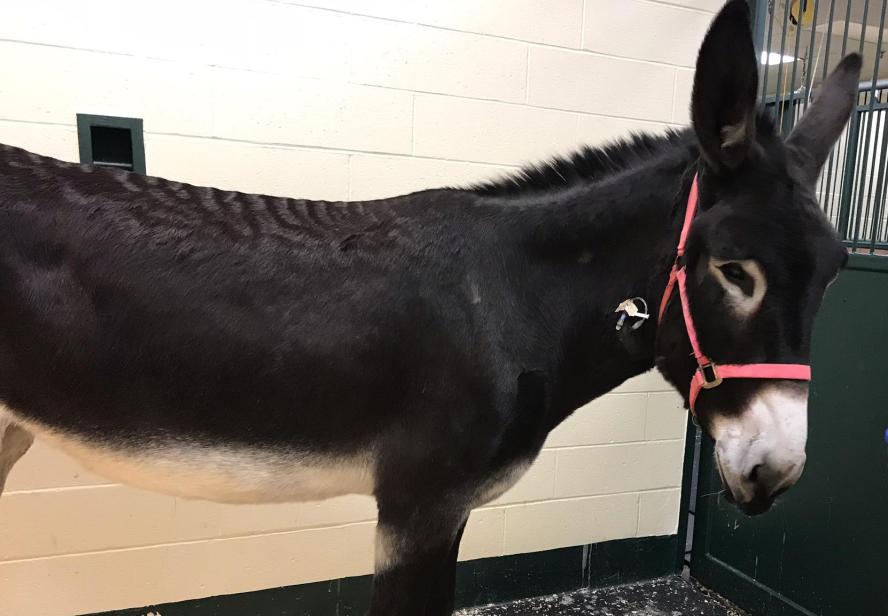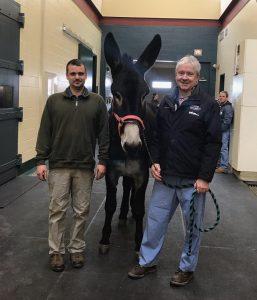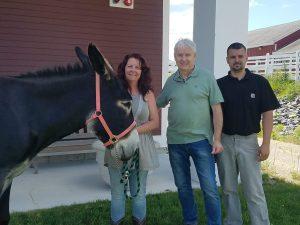-
About
- Leadership & Faculty
- News & Events
-
Academics
- Graduate
- Advanced Clinical Training
- Continuing Education
-
Student Life
-
Research
-
Hospitals & Clinics
- Emergency Care
- Hospital Services
-
Community Outreach
- Volunteer
Best Foot Forward
When a rare American Mammoth Jackstock donkey became increasingly lame, her owner turned to Dr. Carl Kirker-Head for help.

Karen Reid promised herself that she would get her first horse when her kids were grown and out of the house. But, when the time came, she found herself unable to find a horse that she connected with. As it turned out, a donkey was the right match for Reid. Not just any donkey, however–but the American Mammoth Jackstock, a rare heritage breed. “What really appealed to me about the donkey was that they're not flight animals,” she says. “They're just solid riding animals.”
After extensive research, Ms. Reid ventured to Oklahoma to find her perfect companion and fell in love with Hollywood—a Jenny, or female donkey, who stands at 14.2 hands high. But, as Hollywood stepped off the trailer from her journey to Connecticut, Ms. Reid found her new partner had arrived skinny and quite ill. “I think the stress of the trip really made her sick.”
With some antibiotics to help, Hollywood’s condition quickly improved, but it wasn’t long before Hollywood began showing signs of other trouble. She was frequently tripping, which is uncharacteristic of donkeys, and Ms. Reid realized something wasn’t right. But, because Mammoth donkeys are not common in New England and their healthcare needs are somewhat different from that of horses, initially, the farriers and veterinarians were unable to find anything conclusive.
While Ms. Reid remained without answers for months, Hollywood’s issues continued to escalate. Finally, with a hoof abscess that wouldn’t heal, undetermined facial swelling, and a donkey that was losing trust in her owner, Ms. Reid turned to Tufts Equine Center for a solution.
After a CT scan, a quick diagnosis and treatment were made on the golf-ball sized swelling that was affecting Hollywood’s face. “I was so grateful for Tufts because they were able to diagnose her appropriately, treat her, and she was good,” says Reid.
In the meantime, Dr. Carl Kirker-Head, together with farrier and adjunct lecturer, Mr. Eric John, assessed her hoof situation using a comprehensive approach to lower limb management. “She had a quarter crack that had been undermined with dirt and infection,” says Dr. Kirker-Head. “She presented with considerable unsoundness and we determined that it was not a straightforward case, so we recommended that the crack be surgically debrided.”
The experts at Tufts Equine Center again utilized their advanced imaging, which allowed them to see both two and three-dimensionally the involvement of the infection and the crack. The team found that there was extensive damage and two surgeries were needed to treat the injury properly. Though a large amount of her hoof was removed, the procedures proved to be a success. To aid in healing, Mr. John fitted Hollywood with therapeutic boots and she was then moved to a rehabilitation farm to aid in recovery.
With regular follow-ups and careful management from the farrier-veterinarian team, Hollywood healed from the inside out. “Overall, she’s sound and happy and the owners are very happy,” says Mr. John.
“They treated Hollywood amazingly,” adds Ms. Reid. “They knew what they were doing and I think that they treated her like they would treat their own.”
Ms.Reid has been slowly working with Hollywood over the past year since her arrival home and has begun riding again. She looks forward to enjoying their time together, learning and growing as a pair once again. “Mammoth donkeys are amazing riding animals,” she says. “Hollywood is very eager to please and learn.”

